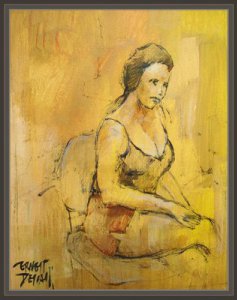![]() IT WAS THE TIME “WHEN LOLA WAS KILLED”. VIDEO.
IT WAS THE TIME “WHEN LOLA WAS KILLED”. VIDEO.
Lola, was a prostitute in Havana and killed her one of her lovers. It could not support that it was so fucking and nailed him with a dagger in the chest. The event occurred at three in the afternoon and its perpetrator they say was a doctor thought that crime would only occupy two lines in the headlines of the evening capital.
But he was wrong and is not known because the President of Cuba Ramón Grau San Martín, in a speech almost at the end of its mandate in 1948, looked at his watch and said three of the afternoon “cone! the time in which Lola killed. The phrase was coined forever in people’s memories of the Cuban people and there is a native of that beautiful land that does not know at the time that they completed the above mentioned company.
Even a well-known song evokes the fact. They were three of the afternoon / killed when Lola / and say those who saw her / that agonizing said / I want to see this man / that removed me the life / I want to see him and kiss him / to die quiet /
https://youtu.be/234RCkUQvqY
The funny thing is this theme, concerned a bolero son, premiered in New York on 27 November 1935 and not composed a Cuban, but a Puerto Rican name Rafael Hernández, known as El Jibarito, and author of the immortal parts Lamento Borincano, El cumbanchero and Campanitas de cristal
Hernandez worked and hired by a transnational company Havana to direct the musical performances and the Orchestra of Fausto Theatre, located in the Prado y Colón, streets between 1919 and 1925 and during this period also participated in the first hearings of the Cuban Radio and she is followed by repeating his visits to the island.
At the end of the 40s of the 20TH century in the program that had, with Lorenzo Hierrezuelo, in Radio chain Suaritos, the unforgettable, María Teresa Vera, sang that song very much and it is speculated that case keeps some similarity with the murder of La Bella Murcia, neighbor of the building of new del Pilar corner to Belascoain, and where Dr. Edmundo was charged more.
Beyond sexist and violent content of the alleged history, Cubans shed it those meanings and paste it erotico-festiva way to our code of social conduct daily and looking at another person leaning forward, is often jokingly say that they killed Lola in that position.
“Better than Lola”, concerns a State of maximum enjoyment, on the other hand mientraa “goodbye, Lolita of my life…!” was the expression of the late Bobby Salamanca, known Cuban radio commentator to narrate the moment in which a player pulled the ball from the stadium in a match of baseball.
The truth is that all the Cubans know that hour killed Lola, but not the exact date of the event and is in doubt if a physician was the murderer, if Grau San Martin mentioned it and if truly she was a ‘woman’s life’ or an imaginary character created from the popular tune.
Agencies/Arrajatabla/Internet Photo/YouTube/Arnold Varona/The Cuban History.com
THE CUBAN HISTORY, HOLLYWOOD.
FOLLOW US ON TWITTER AND FACEBOOK. THECUBANHISTORY.COM
![]() FUE LA HORA “EN QUE MATARON A LOLA”. VIDEO.
FUE LA HORA “EN QUE MATARON A LOLA”. VIDEO.
Lola, era una prostituta de La Habana y la mató uno de sus amantes. No pudo soportan que fuera tan puta y le clavó un puñal en el pecho. El suceso se produjo a las tres de la tarde y su victimario que dicen era médico pensó que el crimen sólo ocuparía dos líneas en los titulares de la prensa capitalina de la tarde.
Pero se equivocó y no se sabe porque el presidente de Cuba Ramón Grau San Martín, en un discurso casi al término de su mandato en 1948, miró su reloj y dijo”coño las tres de la tarde! la hora en la que mataron a Lola. Y la frase quedó acuñada para siempre en la memoria popular de los cubanos y no hay oriundo de esa hermosa tierra que no sepa a la hora que ultimaron a la susodicha.
Incluso una conocida canción evoca el hecho. Eran las tres de la tarde/ cuando mataron a Lola/ y dicen los que la vieron/ que agonizando decía/yo quiero ver a ese hombre/ que me ha quitado la vida/ yo quiero verlo y besarlo/ para morirme tranquila/
https://youtu.be/234RCkUQvqY
Lo curioso es que este tema, en cuestión un bolero son, se estrenó en Nueva York el 27 de noviembre de 1935 y no lo compuso un cubano, sino un puertorriqueño, de nombre Rafael Hernández, conocido como El Jibarito, y autor de las inmortales piezas Lamento Borincano, El cumbanchero y Campanitas de cristal
Hernández trabajó e La Habana contratado por una empresa transnacional para dirigir los espectáculos musicales y la orquesta del Teatro Fausto, ubicado en las calles Prado y Colón, entre 1919 y 1925 y en este periodo también participó en las primeras audiciones de la Radio Cubana y se siguieron repitiendo sus visitas a la isla.
A fines de los 40, del siglo XX en el programa que tenía, con Lorenzo Hierrezuelo, en Radio Cadena Suaritos, la inolvidable, María Teresa Vera, cantó mucho esa canción y se especula que el caso guarda cierta similitud con el asesinato de La Bella Murciana, vecina del edificio de Nueva del Pilar esquina a Belascoaín, y donde resultó acusado el doctor Edmundo Mas.
Más allá del contenido machista y violento de la supuesta historia, los cubanos la despojamos de esos significados y la insertamos de forma erótico-festiva a nuestro código de conducta social cotidíano y al observar a otra persona inclinada hacia delante, se le suele decir jocosamente que en esa posición mataron a Lola.
Estar “mejor que Lola”, refiere por su parte un estado de disfrute máximo, mientraa “¡Adiós, Lolita de mi vida…!” fue la expresión del fallecido Bobby Salamanca, conocido comentarista deportivo de la radio cubana para narrar en un encuentro de béisbol el momento en que un jugador sacaba la pelota del estadio.
Lo cierto es que todos los cubanos saben a que hora mataron a Lola, pero no la fecha exacta del hecho y está en duda si fue un médico el homicida, si Grau San Martín la mencionó y si verdaderamente ella era una “mujer de la vida” o un personaje imaginario creado a partir de la popular melodía.
Agencies/Arrajatabla/Internet Photo/YouTube/Arnoldo Varona/The Cuban History.com
THE CUBAN HISTORY, HOLLYWOOD.






